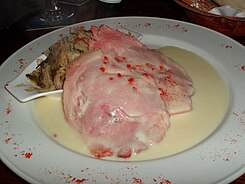Bacon and cabbage
 |
|
| Course | Main |
|---|---|
| Place of origin | Ireland |
| Main ingredients | Bacon (Green back or Smoked) and Cabbage |
| Variations | Corned beef and Cabbage, Pork ribs and cabbage, Breast bones and cabbage. |
| |
|
Bacon and cabbage is a dish traditionally associated with Ireland. The dish consists of sliced back bacon boiled with cabbage and potatoes. Sometimes but rarely with other vegetables such as Mushy peas, onions, carrots, parsnips are sometimes added. Smoked bacon is sometimes used.
The dish is served with the bacon sliced, and with some of the boiling juices (Cabbage water) added. Another common accompaniment to the dish is Mustard paste or Parsley/Onion Sauce, white sauce which generally consists of flour, butter, milk and a herb of some sort (often parsley).
The bacon used for the meal can vary somewhat depending on individual preference. Usually back bacon is used for the recipe, but other cuts of bacon are sometimes preferred. However, the bacon used is almost always cured. The traditional curing process is a long process which involves storing the bacon in salt, however, in modern times, mass-produced bacon is cured using brine which is less frequently injected into the meat to speed-up the process. The bacon can also be smoked which adds a depth of flavour which many people prefer. In Ireland, one can also purchase what is known as home-cured or hard-cured which is bacon cured over a long period and then stored for another long spell, wrapped in paper. This makes the bacon very salty, hard in texture and yellowish in colour.
Historically, this dish was common fare in Irish homes as the ingredients were readily available as many families grew their own vegetables and reared their own pigs. It was considered nourishing and satisfying. The dish continues to be a very common meal in Ireland.
Bacon and Cabbage is renowned as one of Ireland’s best known traditional Irish recipes. Most Irish families in times past would keep a pig and he was known as the ‘Gentleman who pays the rent'. Once the pig had been fattened up over the Summer the pig would be sold to the market and the money from that sale was a major contributor to that all important rent payment. Meat was a luxury for most. Whatever was produced in the house was sold on to pay to help pay the rent. But if you were a wealthier farmer and had made enough money from your crops and labour to pay the rent outright then you might not have to sell the pig in November and you could keep it. The pig would be slaughtered and the meat would then be distributed to your neighbours and when they killed their pig they shared their pig with you. There was no refrigeration at the time so you could not keep the meat, everything had to be eaten fresh and it made sense to have a roster system for killing the pig so everyone had fresh meat and it bound a community more together. They were called ‘meat clubs’. They ate every part of the pig; the only part not eaten was the squeal! Even the bladder was blown up and used as a football by the boys. The one part you kept for yourself was the ham which was salted down and then hung above the fire to give it that nice smokey flavour. This became your bacon which was the special Sunday dish of the tenant farmer. The bacon would be put into the cooking pot and Cabbage then potatoes were added to make this delicious traditional Irish recipe.
...
Wikipedia
